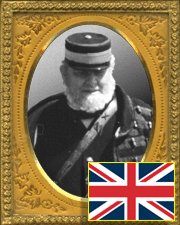
Military Observer's
Journal
 |
A Military Observer's Journal |
|
Military Observer’s Journal
The Go'da'vari River is one of the twelve Holy Rivers of India. From Trimbak where it's first trickle issues through the mouth of a sacred idol, to where it carries into the Bay of Bengal the waters gathered from upwards of a hundred thousand square miles, there are many temples and shrines along it's banks, to which pilgrims come from all parts of India to bathe and be purged of their iniquities. This is especially the case once in every twelve years when it's waters are believed to be in communication with those of the Ganges by a mysterious underground channel.
In 1844 the government of the Presidency of Madras acted upon the advice of Sir Henry Montgomery who had been the Collector at Tanjore and was very familiar with the improvement of commerce and communication that was seen as a result of the flood control and irrigation works of the Cauvery and Coleroon Rivers in 1835 built by that most able of Royal Madras Engineers, Captain Arthur Cotton. The now Major A. Cotton was asked to "send in his report" from which the following extracts are given:
1. "The principal part of the District of Rajahmundry forms the delta of the Go'da'vari River, and as respects soil, climate, and capabilities of irrigation, it can scarcely be surpassed by any part of the world. Such tracts as this, with their immense natural advantages, yet absolutely require the following four kinds of works, before their resources con be in any good degree developed. Even though favoured with a good supply of local rains in general, as is the case with this delta, probably not one-fourth of the produce of which they are capable can be obtained by means of local improvement of the villages on d small scale, and without the did of the main works now enumerated:
"First---The embankment of the rivers, to secure the crops from destruction by the river floods.
"Second---Dams, with channels of irrigation leading from the river, to bring it-s water from the level of it's bad to that of the surface of the land
"Third.---Surplus channels, to lead off the floods caused by local rains, from the flat lands to the sea,
"Fourth,---Raised roads and bridges, to allow of the conveyances of produce to the markets and to the coast, through d country whish is otherwise, from it's nature is impassable during the rains.
It was to these great works that Lt. Ian McKay was drawn in the mid and late 1840s to labor for the benefit of India, and would provide him with his practical experience as a civil engineer, together with his abilities to organize large bodies of laborers, plan for the orderly passage of this work from one phase to another, calculate the needs of equipment, supplies and building materials-, and the ability to draw detailed design and work plans for the job at hand. Lt McKay was to devote several years of his career to this important work, and it served to gain him an enviable record within his service, if not a brilliant engineer, then a dedicated and steady officer with highly developed love of his chosen career and devotion to his monarch
© 1999, James Mathews, all rights reserved. Contact Mr Mathews for permision to reproduce.
Return to the main Société d'Europe page
Return to the table of contents for "A Military Observer's
Journal"
Links to web sites related to this topic:
Society Web Page for James Mathews
The Adventures of Ian McKay